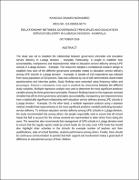Relationship between governance principles and education service delivery in Lubaga division - Kampala
Abstract
The study was set to establish the relationship between governance principles and education service delivery in Lubaga division – Kampala. Particularly, it sought to establish how accountability, transparency and responsiveness relate to education service delivery among UPE schools in Lubaga division – Kampala. The researcher adopted a correlational research design to establish how each of the different governance principles relates to education service delivery among UPE schools in Lubaga division – Kampala. A sample of 218 respondents was selected from study population of 320 persons. Data was collected by use of self-administered closed ended questionnaires and interview guides. Study findings were presented using frequency tables and percentages. Pearson’s correlations were used to establish the relationship between the different study variables. Multiple regression analysis was used to determine the most significant predictor variable among the three governance principles. Research findings based on the responses received revealed that all the three governance principles (accountability, transparency and responsiveness) have a statistically significant relationship with education service delivery among UPE schools in Lubaga division – Kampala. On the other hand, a multiple regression analysis using a stepwise method revealed that responsiveness is the most significant predictor variable predicting education service delivery. To enhance education service delivery among UPE schools in Lubaga division, the study recommended that among others, the people responsible need to ensure that all school heads that fail to account for the money received are reprimanded to deter others from doing the same. The researcher also recommends that management of UPE schools in Lubaga division need to ensure that the regular reports made by school heads do not only cover UPE funds but should also highlight other activities in the schools for example number of teachers and their qualifications, state of school facilities, students performance among others. Finally, there should be continuous communication to parents that their support and involvement makes a great deal of difference in educational success of their children.
Collections
- Thesis and Dissertations [209]

